#ESPECIALLY when the creators clearly intend for the character to be loveable
Explore tagged Tumblr posts
Text
I wish more people were capable of understanding the multifaceted, complex nature of human beings (and thus well written characters).
Like, he doesn't have to be likeable or nice to be caring and occasionally selfless. He doesn't have to be palatable or always make the right choices to be *mostly* well intentioned.
And he doesn't even always have to be well intentioned to be forgiveable! Sometimes people are shitty for a while, and then make the choice to get better! And they're still loveable as a general rule! The people they hurt never owe them forgiveness, but that doesn't mean they themselves are undeserving! And this show is clearly meant to be an example of forgiveness and healing!
If you don't like characters who aren't straightforwardly good, that's fine, but then you probably shouldn't watch this show! It's clearly not for you! Because Izzy isn't any worse than Ed, has the same character flaws as even Stede (though it presents differently) and Black Pete (though he speed ran his learning process) and Calico Jack (though we didn't get to see as much of him).
Ed, Izzy, Calico Jack, and Black Pete all were stuck in cycles of paternal abuse and toxic masculinity! They all took the abuse handed to them by their fathers and captains (who also tend to be metaphors for fatherhood in this show) and hand it in turn down to their own crew!
Stede HALF broke this cycle, by which I mean he only broke it by replacing it with another bad thing-- abandonment. He abandoned both his blood and his found family, in his efforts not to be like his own father. Which is also bad and not helpful and just hurt people!
They're all fucked up and learning! Izzy and ed just took the longest and had the biggest backlash, in part because their relationship was incredibly toxic and they were making *each other worse, and in part because they were both so afraid and genuinely thought this was the only way to survive. (*EACH OTHER, neither of them was solely responsible for this, stop trying to black-and-white a show about people growing and learning).
Just.... It's a comedy fantasy pirate show using dramatised violence and piracy to tell a story about trauma, recovery, and found family. If you don't like it that's fine, but then the show probably isn't for you, and you should probably find something else to watch instead of seething here in our space and throwing negativity at the people who actually enjoy these characters and this story. Characters who ARE narratively intended to be loveable, even if not necessarily likeable.
Izzy IS about community. He’s ALWAYS BEEN about community in his own messed up way. The Canyon was right and the haters were wrong.
He wanted Blackbeard back because that was what kept the crew safe. He was terrible about it and hurt the man he obviously loves in the process, but it WAS for the greater good. It wasn’t a purely selfish act the antis love to frame it as. He wanted to feel safe again and he wanted the crew to be safe as well.
Hell, he was doing his best to help Edward through his post-breakup depression. He didn’t understand what was going on and was clearly distressed by it but he provided what Ed needed. He *knew* he lacked the emotional capacity to help his captain himself so he agreed to bring him Lucius. I really think he would have just gritted his teeth and suffered through it if Ed didn’t say the one thing that could collapse his whole world.
"Why do we even bother being pirates?" That was what freaked Izzy out so much that he pushed Edward to violence. Not because he selfishly wanted Ed to be close at all times but because Blackbeard the legend was the pillar of his community. That legend kept everyone safe and even if Izzy is a horrible asshole, he *does* care about his crew. He knows the world is a horrible hostile place and he focuses on risk mitigation, even if it means hurting the one person he really cares about.
He really tried to provide that to the crew when Edward and Stede took the Act of Grace. It was a terribly misguided attempt at keeping things under control and it was certainly influenced by his submissive tendencies which make him crave structure and feel safe within hierarchies. He *knows* he lacks Ed's charisma and ability to think outside the box and with such huge shoes to fill it's not really surprising he acted out in anger and in result failed miserably. But he was *NEVER* an asshole just for the sake of it.
Now he realizes those days are gone for good. He's already done everything he could to bring Ed back to his senses, including using *Stede fuckin' Bonnet’s* name. It didn’t work. The realization that his one true safeguard is really gone must be terrible, but it also pushes him to take action.
The moment he realizes the crew are in real danger, he takes things into his own hands. He not only goes against the hierarchy he believed to be sacred but also against the man he *LOVES*. He fucking shoots his beloved captain to save the crew. You don’t get much more *community* than that.
He is clearly struggling. He's just tried to fucking kill himself after being maimed AND told he was disposable by a man whom he's apparently served for dacades. He will have to reevaluate his whole life and he *knows* it. But he puts it all to the side and he does what needs to be done. He took all of Edward’s abuse without complaint it seems but the moment the crew are in real danger, he intervenes. You can’t tell me a community (*any* community) doesn’t need people like that.
It all feels very old-time queer to me. The willingness to make terrible sacrifices to protect one's space. The decision (conscious or not) to be effective rather than liked. The choice to stay alive despite terrible heartbreak and go on fighting.
He's absolutely NOT an irredimable villain. He’s an asshole who tries to keep his little world safe. He’s Larry Kramer getting kicked out of GMHC for being too confrontational and politically incorrect to be palatable to the general public.
#ofmd#our flag means death#izzy hands#meta#opinion piece#allow me to editorialize for a moment#sorry for hijacking your post with my emotions about trauma cycle metaphors in narrative#i have. a lot of feelings#and i just think people should stop acting like a show/character is bad just because it's not for them#you don't have to like a character#just don't go around acting like everyone else is wrong for liking them#ESPECIALLY when the creators clearly intend for the character to be loveable#death of the author and all that but creator intentions DO still have ramifications in storytelling#ramifications?#did i mean implications?#maybe?
631 notes
·
View notes
Text
How the diverse world of the addictive tv series “Cherry magic” got made
(interview with scriptwriter Yoshida Erika by Yokogawa Yoshiaki)
沼堕ち続出ドラマ“チェリまほ”の多様な世界はどうやって作られたのか【脚本家・吉田 恵里香さん】2020.12.22 横川 良明
for @howdydowdy because we were talking about what a fantastic character Fujisaki is and the notion of consent when it comes to reading someone’s mind
Currently, societal values continue to change rapidly. On one hand the movement of respecting each other’s diverse individualities and making it easier for each and every one to live in society has become more active, one the other hand it is not a rare occasion to be lost for words when suddenly unconscious discriminatory biases – derived from not being able to cut loose old values that are rooted deep in oneself – raise their heads.
How should we exist within this period of polarization? This series is to create the opportunity to think about this topic by having discussions with the toprunners in the entertainment world. The person I am introducing for the first edition is screenwriter Yoshida Erika.
She is behind the script of “Thirty Years of Virginity Can Make You a Wizard?!”, the tv series that has grabbed the first spot on the oricon satisfaction ranking for 4 weeks in a row, and has gained fast popularity despite its late-night spot. The enthusiasm for the show can be attributed to the soft view Ms. Yoshida has on the world.
Yokogawa Yoshiaki (YY): I am happily watching the series. I really liked the original work, however the way it was adapted to a television format has been brilliant. One big thing is the making of the character of Kurosawa played by Machida Keita. By Adachi’s magic (played by Akasouji Eiji), the voice of Kurosawa’s heart spills out, and while the original text had him be quite blatant in his expressions overall, the drama carefully examines them.
Yoshida Erika (YE): That is definitely where there is a difference in depth. The original has the premise of a work in the BL genre, readers are expecting a BL-like development, so they can take such things in stride, but the viewership of the tv series is more varied. Under them there might be people who do not like BL. That is why I was conscious about how different people from different backgrounds might watch this show.
It is not okay to assault someone just because you were invited to their house, kissing or touching without consent is not okay and being of the same or different sex makes no difference in this. Treating such things as okay because it is BL would be rude to the parties concerned. Because we are using the BL genre, we want to specifically protect the “firsts” of the parties concerned. That is something the producer Ms. Honma Kanami and the director agreed about and I therefore paid extra attention to.
YY: Adachi himself, as he is about to step into Kurosawa’s house thinks “Not that I might possibly get assaulted?!”, and is very vigilant, but with some soul-searching realizes that that is rude towards Kurosawa. To say it briefly, you can feel the probity of the creators.
YE: I thought that a main character that thinks that he will get assaulted when he steps into the house of someone will not be loveable. No matter how well received the person is who acts it out, if we cannot love them on a human level, this drama will not work. Adachi’s power to read people’s hearts is also the action of seeing people’s darker sides on his own volition. That’s why a character we cannot love as a person will receive push-back by the viewers.
YY: Just like you said, the act of reading peoples’ hearts includes great violence. That is why I think that when he realizes that Kurosawa has fond feelings for him, unlike the original where he reads Kurosawa’s heart on purpose, the drama treats it as an accidental force. Over the whole series, it is of focal importance that Adachi doesn’t overuse his magic.
YE: That is where we were extremely careful. In the manga easy comprehensiveness is important and that type of suspense is interesting - and we don’t intend to deny that - but if you do it as a drama, I didn’t want to make him into a young man using his powers at ease. That is why, especially in the first half, he decides and tries very hard not to use his powers when possible. The scene where he reads the CEO’s heart appears in the first issue of the original, but in the drama we pushed it back to the 5th episode. We made it a point to illustrate how Adachi is filled with the emotion to help Kurosawa and that is why he uses his powers.
-
That what I don’t want others to do unto me, I do not want to inflict on characters.
-
YY: His colleague Fujisaki (Satou Ryo) is a Fujoshi in the original and that premise was cut from the series. If you decided to have a Fujoshi character on a prime time show, did you think that misunderstandings might arise easily?
YE: That was definitely a thought. In BL as a genre it is not an issue that a character exists that takes the same viewpoint as the reader, and I love Fujisaki in the original, but the people who are acting it out in reality are real people. At that point, loudly fawning about someone else’s’ love life is not perceived as good conduct. At the least, I thought that I wouldn’t want to be treated like that.
YY: It is fine to envision fictional characters as romantic partners, but it is different when you make a real acquaintance the target of that.
YE:
A thought we had was that if Adachi and Kurosawa were to really date it would be one thing, but grinning at someone - who might even be heterosexual – because you inflate your own BL adjacent delusion isn’t much different from a man grinning at a woman with big breasts and calling her sexy. I wouldn’t want to get treated that way, so I didn’t want to inflict that on the characters in the story as well.
When it comes to Fujisaki it isn’t like she isn’t a Fujoshi. We do not clearly state it, but I thought there was no reason to show it in the drama.
YY: You are saying, that it is fine that people might interpret Fujisaki as a Fujoshi when she is smiling at Adachi and Kurosawa.
YE: Yes. That is where you are free to imagine (laughs).
YY: What I thought was very fresh is that instead of proclaiming her to be a Fujoshi, Fujisaki is turned into someone who “is happily living her daily life even without romantic love”. We don’t often get characters like that in Japanese tv series.
Personally, I also like romantic tv series, but while feeling venerated when the main characters have realized their love in the final episode, when trying to build a romantic connection to someone else in real life it might not go well and beyond that, it is not that it never happens that I, who also holds interests in other things than romance, end up feeling empty because of the lonely feeling of having been left behind (when watching a romance on tv unfold).
But with having Fujisaki appear, it felt like I got rescued.
YE: Until now, for several projects I made the suggestion of a character that is not interested in romance, but I wasn’t understood. “Is it necessary to do that?” “Aren’t you overthinking it?” were things I got told often.
But with this production, when I said that I wanted Fujisaki to be asexual or aromantic, no one denied me. From that stage on I thought that this place was a good one, and thanks to the original writer giving her agreement it got turned into reality.
YY: Since this kind of character hasn’t really appeared in a tv series, it felt like people like Fujisaki were assigned to be non-existent in this world. But thanks to you envisioning her like this, seen from a person that like Fujisaki might say “I got used to acting “normal”” and feel a notion of despair when confronted with people not understanding them, it felt like it got emphasized that people like her also exist in our society. Picking such little voices feels like it is one of the purposes of entertainment.
YE: If that could become the case I would be glad about it. 10 to 20 years prior, a “fairytale gay” (describing the flamboyant gay friend, that mentally supports the heroine by giving some harsh but accurate advice) often appeared in tv series from abroad, but this portrayal slowly changed, finally it has reached the point where the view point that being gay isn’t something special has penetrated the public.
So this time, I believe that one of my duties was to tell the story of people that are not interested in romance or people who do not only love one person, not from a standpoint that is convenient for consumption, but to have properly realized characters up to their individual backgrounds.
-
I hope the time comes where it isn’t necessary to especially say “This is a BL series”
-
YY: Please let me speak on something that has confused me this far. Prior, when you explained Fujisaki in context of the script, it felt like it wasn’t okay to call her asexual or aromantic because she herself doesn’t use any of those labels. I was somewhat afraid that an outsider would just selfishly declare that “you are asexual, aren’t you!?” in regards to someone who hasn’t professed anything.
YE: There is the point of both of the terms asexual and aromantic not being widely known in Japan as much as compared to overseas and I also think there are people who just wouldn’t use these words. Even when you think you are not interested in romance at the moment, it could also be that you just haven’t found the person that makes you feel that way. That’s why I can understand how labelling someone has a violent notion.
YY: My next question is also relating to that: This applies to Cherry Maho, but generally when I write about over works that feature a lovestory between men I try not to use the word BL.
This is my own opinion but to me it feels like the term BL has too much of a sexual image.
In private I casually use the word BL. However, for the content of an article that is read by an unspecified number of people, I remember stumbling over labelling something as BL. Using BL as an easy genre specifier has the effect that there will be a layer that won’t get looked at. I simply want to have more people enjoy a piece of work. I don’t object to the editor using BL in the title but in the content I write, I try not to use the term BL story but simply “love story between two men” and keep it close to how you’d address it in reality.
YE: I understand that. Obviously, I don’t intend to shame the taste of people that like BL. However, I understand that there are people that feel a sense of resistance towards BL as a genre. That is why I also don’t use the word BL when I promote on twitter. I do think that it would be great to have a new word.
Just like women have things they don’t want to be subjected to, men also have things they don’t want to be subjected to. This kind of awareness has become more broadly spread bit by bit. However, in order to have it really penetrate society it needs for the voices of the affected people to be heard. But it is also the reality of today’s society that violence is directed at people that raise their voice. That is why I feel like it is the job of the people that create tv shows to speak up instead.
At the least, that is how I want to straightforwardly create the world, so that in 10 years without directly stating “this is a BL series” we have a society that takes it in as a “new cool romantic drama beginning” with “the leads being actor x and actor z” and as nothing unusual. Now we really have such a transitional period, and as a writer I want to build the steps towards it.
-
original article: https://mi-mollet.com/articles/-/27045?page=3&per_page=1
#cherry magic#thirty years of virginity can make you a wizard#30歳まで童貞だと魔法使いになれるらしい#30 sai made#a bit rusty with my translations but i really enjoyed how they were talking about the writing and character composition in the series and#decided that I had to share#long post
112 notes
·
View notes
Text
Mortal Kombat and Bloodsport: The Strange Connection That Changed Gaming
https://ift.tt/3vd5lXB
As we eagerly anticipate the release of the latest Mortal Kombat movie, many find themselves looking back on Mortal Kombat’s 1995 big-screen debut. While that film has its charms and its fans (myself included), the movie has rightfully been criticized over the years for lacking many of the best qualities of the game as well as many of the best elements of the martial arts movies that clearly inspired it.
Of course, the relationship between Mortal Kombat and martial arts films has always been close. Not only did the game utilize a then-revolutionary form of motion capturing that gave it a standout cinematic look, but many aspects of the title were practically taken directly from some of the best and biggest martial arts movies of that era.
As the years go on, though, it becomes more and more clear that no martial arts movie impacted the development of Mortal Kombat more than Bloodsport. Maybe you’ve heard that MK was inspired by that beloved movie, but a deeper look at the relationship between Bloodsport and Mortal Kombat reveals the many ways both big and small that the two would go on to change gaming forever.
Bloodsport: The Crown Jewel of Absurd ‘80s Martial Arts Movies
While the 1970s is rightfully remembered as the decade when America became obsessed with martial arts (due in no small part to the influence of Bruce Lee’s legendary films), it really wasn’t until the 1980s that you saw major and minor studios compete to see who could produce the biggest martial arts blockbuster.
Of course, many of the martial arts movies of that decade were different from what came before. They had bigger budgets, were usually more violent, and, maybe most importantly, they generally catered more to Western audiences. Yes, the ‘80s is the decade that Jackie Chan and other Asian martial artists did some of their best work, but as more and more Western studios got in on the action, we saw the rise of a new kind of martial arts movie that more closely resembled the over-the-top violent action films popularized by Arnold Schwarzenegger.
That also meant the rise of a new kind of martial arts star who was typically either from America or played American characters in what we can now see was an effort to capitalize on the idea of American exceptionalism that was especially popular during the Reagan era. If you’re looking for some notable examples of that trend, I’d suggest checking out Best of the Best, Above the Law, and, naturally, American Ninja.
In many ways, though, 1988’s Bloodsport is the pinnacle of that time in martial arts movies.
Bloodsport co-writer Sheldon Lettich says he came up with the idea for the film while talking to a martial artist named Frank Dux. Among other things, Dux claimed to be a former undercover CIA operative who once participated in an underground martial arts tournament known as “Kumite” in order to take down the criminal organization that ran it. Dux also claimed he was the first American to ever win the tournament.
To be frank, Dux was full of shit and, despite the fact that Bloodsport bills itself as a story inspired by true events, Lettich knew it. Still, the idea of an American martial artist winning a global underground tournament featuring the world’s greatest fighters was too good to pass up.
Indeed, the absurdity of that premise is a big part of what makes the whole thing work. While Dux’s story was almost certainly “inspired” by the plot of Enter the Dragon, Bloodsport wisely veers away from that classic in ways that take advantage of the best (or at least most loveable) elements of that era.
The smoke-filled back room that hosts many of Bloodsport‘s key fights is far removed from the tropical paradise of Enter the Dragon, but it captures that vibe of an ‘80s pro wrestling arena where the stale air is punctured by the screams of a bloodthirsty crowd. Whereas many early martial arts movies were designed to showcase the speed of their leads, the deliberate, slower strikes in Bloodsport perfectly compliment the absurd sound effects they resulted in which suggested that every punch was breaking bones. It’s a ridiculous idea tempered by a surprising amount of raw violence. In a nutshell, it’s a snapshot of what made so many great ‘80s action movies work.
What really made Bloodsport special, though, was the work of Jean-Claude Van Damme. It’s hard to call the young Van Damme’s performance “good” in any traditional sense of the word, but considering that he was cast in the role to be a good looking young martial artist with charisma to burn, it’s also hard to say he didn’t do exactly what he was asked to and then some.
More important than JCVD’s movie-star looks were his martial arts abilities. I don’t know how Van Damme’s real-life martial arts experience stacked up against the best competitors of that era, but what I can tell you is that Van Damme came across as the real deal at a time when many studios were still casting the biggest bodies and teaching them to be action stars later. By comparison, Van Damme was lean, flexible, and not only capable of selling us on the idea that he could kick ass but genuinely also capable of kicking many asses.
Bloodsport was a box office success that would certainly go on to become a genre cult classic, but its most lasting impact has to be the way it introduced so many of us to Jean-Claude Van Damme. Indeed, the attention the movie brought to Van Damme was about to also make waves in the video game industry.
Midway to Hollywood: “Bring Me Jean-Claude Van Damme!”
Much like the tales of Frank Dux, the stories of the early days of Mortal Kombat’s development are sometimes twisted by legend. However, nearly all versions of the story come back to Jean-Claude Van Damme in one way or another.
Mortal Kombat‘s origins can be traced back to co-creators John Tobias and Ed Boon’s desire to make a fighting game featuring ninjas that would also allow them to utilize the kind of large character designs they emphasized in previous works.
Unfortunately, the initial pitch for that project was rejected by Midway for the simple reason that there seemed to be some doubt regarding the commercial viability of an arcade fighting game. Remember that this was all done before Street Fighter 2 really took over arcades, cemented itself as a game-changer, and inspired studios everywhere to start go all-in on the genre.
Instead, Midway decided to pursue an action game starring Jean-Claude Van Damme. The details of this part of the story sometimes get fuzzy, but it seems they specifically hoped to develop a game based on Van Damme’s Universal Soldier film. At the very least, the idea of adapting the mega star’s latest movie into a game must have seemed like a much more surefire hit than an unlicensed fighting title.
Recognizing an opportunity, Tobias and the rest of the four-person team that would go on to make Mortal Kombat decided to see if they could get Van Damme interested in the idea of starring in their martial arts game. Boon recalls that they even went so far as to send Van Damme a concept demo for that project by capturing a still of the actor from Bloodsport, cropping out the background, and replacing it with their own assets. There have even been reports that they were prepared to name their game Van Damme as the ultimate showcase of the star.
The idea fell through, and there seem to be some contradictory reports regarding exactly what happened. Boon once said that he’d heard Van Damme already had a deal in place with Sega that would conflict with their offer, but, as Boon notes, Sega clearly never released that game. If such a deal ever was in place, it seems nothing ever came from it. It’s also been said that Van Damme was too busy to model for the game’s digitized animations or was otherwise simply uninterested.
The entire Van Damme/Midway deal ending up falling apart, but there was a silver lining. Now given the time to properly recognize that the fighting genre was blowing up in arcades, Midway told Tobias, Boon, and the rest of the team to go ahead and work on their martial arts game, Van Damme be damned.
While Van Damme was technically out of the picture, the team at Midway were hardly ready to give up entirely on their idea of a fighting game inspired by Bloodsport
Read more
Movies
Mortal Kombat: An Ode to Johnny Cage and His $500 Sunglasses
By David Crow
Games
Mortal Kombat Timeline: Story Explained
By Gavin Jasper
Mortal Kombat: A Bloodsport by Any Other Name
Mortal Kombat went by a lot of names in its earliest days (the most popular candidate in the early days was reportedly “Kumite“), but one thing that remained the same throughout much of the project’s development was the commitment to making it the anti-Street Fighter. Or, as Ed Boon once put it, to make it the “MTV version of Street Fighter.”
The logic was hard to argue against. If Street Fighter 2 was the best at what it did, then this game should be the exact opposite of it in every single way possible
What’s impressive are the ways the small MK team distinguished their project. They used digitized captures of actors, which is particularly impressive when you consider that they weren’t even working with green screens. They just filmed some actors (mostly people they knew with martial arts experience) performing moves against a concrete wall and then manually removed the real-life backgrounds. It wasn’t too far removed from the techniques they used to construct a demo of their idea for Jean-Claude Van Damme
Of course, you can’t talk about MK without eventually talking about the blood. The game’s use of gore was certainly intended to catch people’s attention, which it absolutely did. While the MK team didn’t quite anticipate how the combination of digitized actors and extreme gore would put MK at the center of an emerging debate about video game violence, they rightfully predicted that the game’s violence was one of those things that people would force people to stop and look when they walked by and saw the game in action.
What’s really funny, though, is how those two qualities helped MK capture the feel of Bloodsport in ways that seemed both intentional and perhaps happily accidental. Yes, MK’s origins prove that it was clearly inspired by Bloodsport, but the ways in which MK most meaningfully mimics Bloodsport often aren’t talked about enough.
In Bloodsport and MK, you have this martial arts adventure that feels both wonderfully dingy and strangely fantastical. Just as Bloodsport told the unbelievable story of a global tournament featuring larger than life participants but tempered it with visceral combat the likes of which no human could survive, MK combined sorcery and mythological creatures with decapitations and punishing uppercuts in a way that shouldn’t have worked but proved to be too enjoyable to at least not be fascinated with.
Even the “awkward” animations you sometimes have to suffer through as a result of MK‘s motion capture process captured the spirit of Bloodsport and the ways that it replaced the smooth moves of someone like Bruce Lee with a more impactful MMA-esque style complimented by moments of absurd athleticism. It’s almost certainly also no coincidence that the average MK combatant’s most athletic move was a sweep kick. After all, a famous Hollywood legend says JCVD was offered the Bloodsport role after showing off his kicks to a producer.
Of course, when it comes to any discussion about MK and Bloodsport’s relationship, we certainly don’t have to rely on possible coincidences and speculation. Not only was an early version of MK literally ripped from Bloodsport, but as it turns out, JCVD did end up appearing in the game…
Johnny Cage: Jean-Claude Van Darn
If you step back and look at it, Mortal Kombat is basically the Super Smash Bros. for action stars of the ‘70s and ‘80s. Kano was a callback to The Terminator, Sonya Blade was seemingly based on the eternally underrated Cynthia Rothrock, Raiden was clearly inspired by Big Trouble in Little China (as was Shang Tsung), and Liu Kang was almost certainly a Bruce Lee substitute.
Then you have Johnny Cage. As a cocky movie star whose martial arts skills are largely based on his flexibility, it’s always been easy enough to suggest that Johnny Cage is a non-licensed nod to Jean-Claude Van Damme. Actually, many think that Johnny Cage is a bit of a mean-spirited parody of JCVD meant to mock him for turning the game down.
The truth is a little more complicated than that. Johnny Cage actually started as a character named Michael Grimm who was described as the “current box office champion and star of such movies as Dragon’s Fist, Dragon’s Fist II, and the award-winning Sudden Violence.” While his character model was reportedly also influenced by Iron Fist’s Daniel Rand, it seems that he was initially meant as a kind of broad substitute for the Western martial arts stars that took over the scene in the 1980s.
But yes, Johnny Cage is absolutely meant to be a parody of JCVD. I suppose where people lose the thread a bit is in the insinuation that he’s a jab at the star rather than an homage. While MK’s developers have said that Johnny Cage’s iconic “splits into a low blow” was absolutely a way to poke fun at JCVD and a scene from Bloodsport, it feels a little disingenuous to suggest the team was feeling bitter about not being able to put JCVD in their game and wanted to suggest that he was this star that was somehow too good for them.
What’s kind of funny, though, is that the rise, fall, and rise of Johnny Cage isn’t too dissimilar from what happened to JCVD. Van Damme was riding high in the early ‘90s on the back of films like Bloodsport, but a series of flops and some personal problems put his career in jeopardy later on. Similarly, Johnny Cage debuted as the prototypical Hollywood star but would fall from grace in the years that followed. He wasn’t even featured in Mortal Kombat 3 for the simple reason that he was the least selected character in MK 2.
Yet, over time, many people came to appreciate characters like Johnny Cage and actors like JCVD largely because they represented this golden age of absurd martial arts movies that weren’t always great (and were certainly usually a little problematic) but were ridiculous in a way that became much easier to love when weighed against increasingly self-serious genre works.
In his own way, Johnny Cage not only represents JCVD but the magic of a movie like Bloodsport and how such a silly little film could change everything because of (and not in spite of) its ridiculousness.
There’s another world in which JCVD became the digitized star of what would become Mortal Kombat, but due to a series of incredible circumstances, we don’t just need to project that reality on Johnny Cage to envision what that game might have looked like.
Bloodsport: The First Great Video Game Movie?
While it’s certainly funny enough that Jean-Claude Van Damme would go on to star in the Street Fighter movie after turning down what would become the first Mortal Kombat game, the cherry on the top of that story has to be the release of 1995’s Street Fighter: The Movie (the game).
That adaptation of the Street Fighter film bizarrely abandoned the design style of the Street Fighter games the movie was based on and was instead modeled after Mortal Kombat in an attempt to give Capcom a fighting game that could more directly compete with Midway’s runaway hit series. It failed spectacularly, but it did feature a digitized version of Guile as portrayed by JCVD in the Street Fighter movie. Van Damme even lent his moves for the game’s motion capture process.
Roughly four years after passing up the opportunity to star in Mortal Kombat (or Van Damme, as it would have likely been known), Van Damme ends up starring in a Mortal Kombat rip-off carrying the Street Fighter name. Call it a missed opportunity if you want, but to me, the bigger takeaway is that Van Damme may have missed the chance to recognize that he, Bloodsport, and Mortal Kombat were destined to be together long before the development of MK ever started.
See, there’s a scene in Bloodsport where Frank Dux and his new friend Ray play the 1984 arcade game Karate Champ. As one of the first successful arcade fighting games featuring multiplayer, Karate Champ would later be recognized as one of the fundamental pieces of the genre. John Tobias even said that Karate Champ was more of an influence on Mortal Kombat than Street Fighter was.
What gets me most about that scene, though, is the trash talk. Ray asks Frank “Aren’t you a little young for full contact?” Frank counters by asking, “Aren’t you a little old for video games?” They settle by playing another round.
It’s a simple sequence that’s hard not to look back on as an early indication that the popularity of films like Bloodsport would directly influence of new era of fighting games defined by competitiveness, arcade trash talk, and advancing technology that would inspire fans and developers to replicate the feel of being at the Kumite or, in our world, in a movie like Bloodsport.
In the same way that Mortal Kombat is basically an unofficial Bloodsport game, maybe it’s time to look back at Bloodsport as a kind of unofficial video game movie. After all, it may have debuted at the end of a strange kind of golden era for Hollywood martial arts films, but it was just the beginning of the golden age of fighting games.
cnx.cmd.push(function() { cnx({ playerId: "106e33c0-3911-473c-b599-b1426db57530", }).render("0270c398a82f44f49c23c16122516796"); });
The post Mortal Kombat and Bloodsport: The Strange Connection That Changed Gaming appeared first on Den of Geek.
from Den of Geek https://ift.tt/3eiNTKM
0 notes
Text
Bloomtrospective Part 1: The Academia Waltz or Birth of an American Stinker

Once upon a time in Austin, Texas, University of Texas student Berkely Breathed, a smartass with a mustache to this very day and a loveable goofus of the highest order, was recently out of a job, thrown out on his ass by the Austin-American Statesman for one of his cartoons pissing people off. It would not be the last time one of his cartoons pissed people off, nor the end of his cartooning career, though it would probably be the last job he was outright fired from.. maybe he might of delivered pizza's, stripped or fought grown men and/or walruses for money.. I don't know what he did in his spare time.
And not long after, he found a new , regular cartooning gig in the daily texan, UT's newspaper and since college papers give far less fucks about people yelling at them than national newspapers, which gave way TOO much of a fuck about people yelling at them over comic strips, Berkely had his first regular gig. and it was this gig that lead to thousands of comic strips, 3 more series later on, plushies, an animated special, a failed pitch at dreamworks, t-shirts, bill watterson getting pissy with him, pearl clutching from concerned elderly people, letters from harper lee and lenoard nemoy, and a small album made by fans. And it all started with a small time semi-doonesbury knockoff starting an obnoxious fratboy.
Welcome one and all, to Bloomtrospective, my retrospective covering all 14 years of bloom county, and every year of it's prequel and sequels. For those not aware bloom county is a comic strip that was started by Brethed in december 1980 and went on to run till mid 89, becoming one of the most influnetal and funniest comic strips of all time, often getting into political and celebrity satire and weird shenanigans. I"m, as you can probably tell by this insane undertaking, a massive fan and more than happy to dive into all 28, yes 28, years worth of content it's creator , Mr. Brethed, put out. And before you ask, yes virginia, that is his real name. But before I can get into bloom county proper, as you can probably guess i'm tackling his college strip, the Academia Waltz.

The reason is simple: I want to track his full evolution as an artist and professinal smartass, and a lot of what would become bloom county is in the primordial ooze of this strip. That's not metaphorical either: around 41 gags, give or take one or two that are similar but not identical, were recycled for Bloom County , with a paticular gag getting recycled three times, a gag i'll get to next time as it's the very first Bloom County strip and frankly deserves a paragraph all it's own. That being said, the strips were hilarious and worth a recycle and frankly not a lot of people probably saw this strip first run, so recyling his best stuff for a wider audience is just good practice. It was done before him with Doonesbury's Gary Tredeau before him and Pearls Before Swine's Stephan Pastis after him recyling their college and web strips for syndication.
And this is far from the only way Waltz follows in Doonesbury's footsteps. For those unaware of the strip, Doonesbury is a political strip started in 1969 that's STILL GOING, albeit sunday's only since the early 2010's, and was one of the most popular and well loved strips in the world at the time Waltz came out. Brethed has out and out admitted that he curbed from the strip for Waltz and early BLoom County and implied, likely sarcastically but given Tredeau is a smartass himselff I can't be entirely sure, that Tredeau sent him obsecntiy filled letters in response. And for the record the two are now on good terms and likely were by mid-bloom county, and it's just as likely the letters were in good fun. Both series do have a main charcter, though in doonesbury's case one of many, with sunglasses and a surly conservative attitude, and several of waltz side cast resemble doonesbury characters. And Brethed wasn't blind to this, eventually poking fun at himself late into Waltz' run.
But now with that Elephant firmly out of the room, we can move onto the strip itself which starts... with a bunch of formless one off strips about random people before solidly getting into a main cast, as i'll be going character by character here. Though for starters i'll be focusing on two: Steve and Kitzi


Our main schmuck is Steve Dallas, one of the main reasons i'm covering the strip as, along with Opus, the penguin whose the main character of Berke's works as a whole and who we'll get to in an enstalment or two, is one of the few characters Brethed uses in every single strip after this and the only one to have a lead roll in all four.
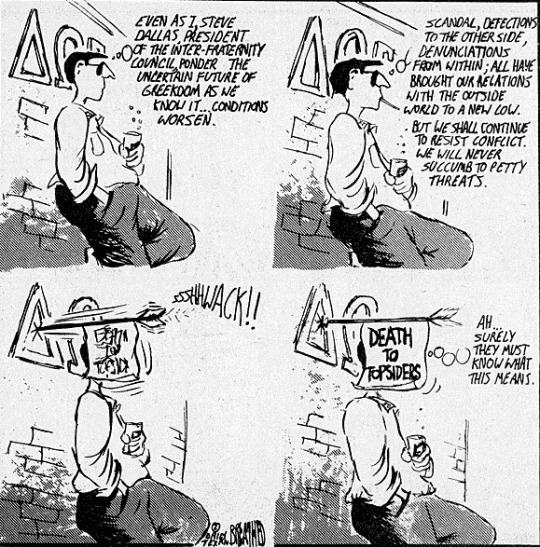
Steve is an obnoxious, racist, sexist, immature, attempted cheating, asshole of a fratboy. He was based on a friend of Berke's who hasn't come out of the woodwork to beat him senseless yet. The character was intended to be a saterzation of fratboys and toxic masculinity, but sadly as happens often several fratboys saw him as a figure to be looked up to and missed the joke to Brethed's annoyance. And he works well as that and decently as a unsymapthetic protagnist, but I do also see easily why he ended up not being the main character of BLoom County itself and more one of an ensemble with Opus and Milo taking center stage: he's an asshole. It's funner watching his misadventures with someone besides his girlfriend who should've left him LONG ago and who he threatens to molest at one point...
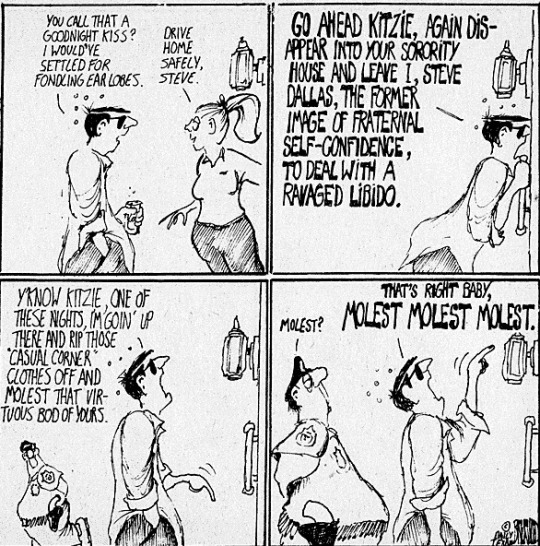
A gag that clearly hasn't agred great, though I concede that put in context of the time it's okay and compared to some shenanigans in 70's and 80's frat comedy, it's tame by comparison. But while not terrible here Steve works at his best with a strong personality to play off of, like most of the bloom county cast, especially as a double act with Opus at times later on. Here while there is a good bit or two with his girlfriend and soriority girl Kitz, like the condom gag used up top.
There just.. isn't that much to her till the last leg of the strip. For most of it she's just a flat character who wnats more from the relationship and refuses to sleep with Steve for most of the strip because he's Steve. She DOES sleep with her professor, in an arc that is absolutley dreadful by today's standards, as she is very clearly drunk when both she calls him and comes over, and not only doe she sleep with him. But well....
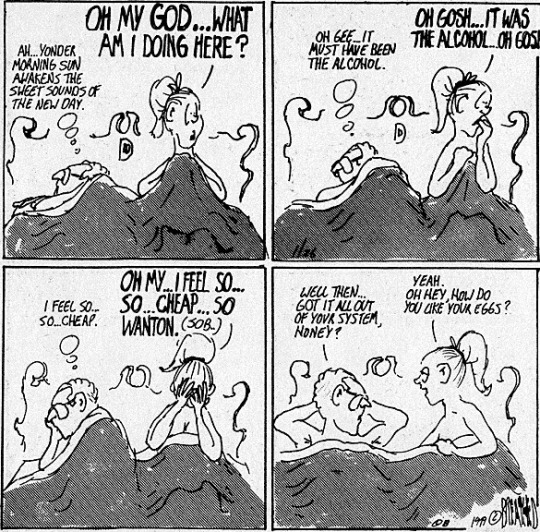
Yup, this has happened before.. and look i'm not saying dark jokes can't be played for laughs, again the above molest gag really isn't that terrible in the context of the time, mostly because steve gets caught and presumibly roughed up immeditly. Here? A teacher takes advantage of his student, has done so with them before, and will again and it's portrayed as cheating rather than Kitzi you know, being raped. It's not great is what i'm saying, though I don't hold present day Brethead acountable for it and I doubt he's all that proud of it. He didn't exactly use this arc to represent the strip any time waltz was reprinted before he let it be fully reperinted and wasn't proud of the strip as a whole, it's just a strip that dosen't hold up well int he Me Too era and the character himself can go have sex with a rake.
Moving on from that nightmare, Kitzi DOES get an arc towards the end where she does change a bit, deciding, out of nowhere really, to change her look up and her major.

This verison does in fact sleep with steve, Ugh, but is also a slightly better foil for him and would later be the basis for a character we'll get to next time, Bobbi Harlow, who'd be a more fully realized verison, but still hasn't changed that much: she's a feminist sure but her role with steve is still the smart woman to the dumb traditional male, a dynamic that's been done to death by now, and even taking it in the context of the time just isn't that funny. She's mostly a cardboard cutout of a woman used to serve as Steve's foil and Bobbi after her would be a bit more fleshed out character wise. But we'll get to her next time.
Now onto another charcter, one who'd be fully imigrated, if breifly to Bloom County.
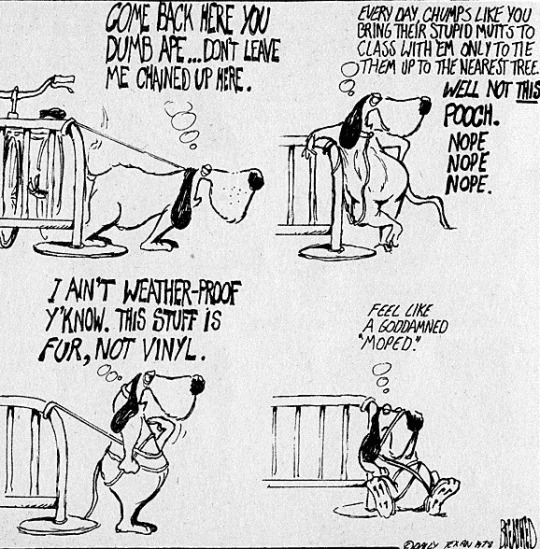
This is rabies, a dog. He'd be abandoned partway into the next strip because as Berke himself put it, there was no shortage of cartoon dogs, and his personality would largely become that of Milo and the forest animals. However for this strip.. he's great, consiently funny, well drawn and the most entertaining part. Some of the best bits with steve are playing off this old boy and here are some of his highlights.
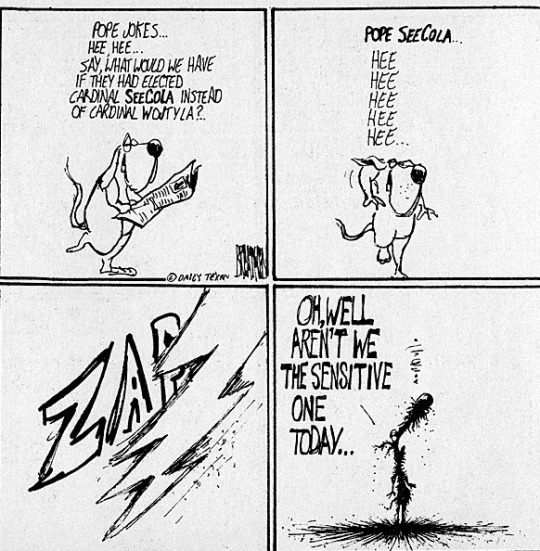


Not much else to say really, he' a funny, dry sacracstic character and to me feels kinda like the blueprint for the vast majority of berke's characters to come.

Next up is Saigon John, though he’d be called Cutter John in Bloom County. He's one of the only two characters to be important to any of the following strips along with Steve. In Both strips he's a ladies man and vietnam vet, though here he's more of an out and out hippie. He's still remarkably fleshed out for this strip and even gets a full origin story at one point, that while starting goofy with Cutter having turned his rifle into a bong the final two strips are pogniant, and while having a good joke in there... still treat his being paralized in a warzone with the weight it deserves.




A standout in this run and a sign that berke does have a knack for emotinal beats as well as damn good comedy. He was also steve's roomie for a while... nothing really to go into there, just something I felt needed mentioning.

Finally, out of the major characters, we have Val, kitzi's roomate who ironically is never seen with her as frankly Kitzi is basically built to orbit around steve. I do like Val a lot though, an average looking young woman looking for love.. but as seen above usually just ends up trying to surivive an evening with some jerkhole. She's a sympatheic enough character and while she does show up for the finale, she dosen't really get an ending. Get used to that as Berke has a habit of dropping characters abrubtly. Speaking of which it's now time for a character lightning round. Outside of our main 5 here the strip had a TON of characters that didn't really do much and whose names I struggle to remember. There's Halfoat a crossdressing football player whose a mixed bag.

Their hard to read as it's hard to tell if their transsgender or just wear women's clothing and this being a 20 something berkely brethead a time when those sorta things were given about as much thought as the producers of Cats gave the idea of making the characters not look like a crime against .. well everything really. But at least the people with an issue against them are treated as morons and Halfoat is portrayed as confident and accepted by most of the team except for the douche above.
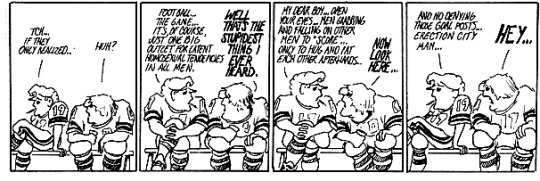
Fairing a little better is Threser, another football character before they dropped that gag entirely as it was basically Doonesbury's football strips but with no idea what to actually do with them besides ocasinally throw in an LBGTQ person in there and have the rest of the team be idiots about it. But Thresher is self assurred and enjoyable.
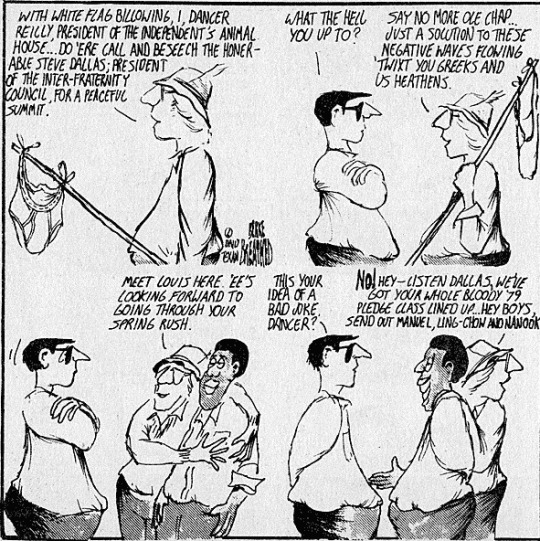
Next we have dancer, a combination of Zonker and Mark Slackmeyer from doonesbury who.. really dosen't have mcuh in the way of personality. He has an accent and that is. The british australian mismash of an accent would come up again in bloom county with LImekiller, a doonesbury ripoff for another day, but otherwise he's basically nothing.
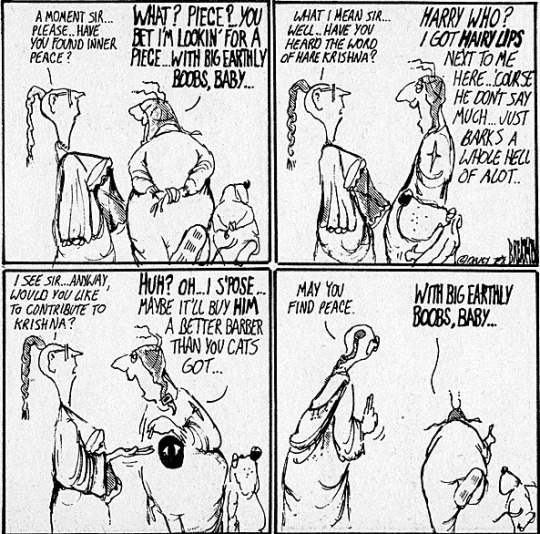
Finally we have the WEIRDEST edition to this cast, Trooper, who appeared for 4 or 3 strips. A very transparent Zonker Harris from Doonesbury knockoff, with the odd as hell twist of "he's an alien". While BLom County would later have aliens and other weirdness from time to time, it worked because it was a hightned version of the real world, something that would be used ocasionally in waltz, but not enough yet at this point to make this any less what the hell. Just a weird footnote. But as you can tell most of these characters are also rans. THere was also a facultiy member warring against medicority, Louis berke's first POC character seen above, some guy who showed up for a while but had no reanl name or personality, Val's mother, Steve's sister and a few one shots but the strip ran through characters pretty quickly. However that does give me the lisecne to bring in the dropped character count!
Dropped Character Count: 9
9 already and with val and Kitzi both being dropped, though kitzi would be resued in a WEIRD way later on in bloom county. that already brings us up to Dropped Character Count: 11
And we've only just begun folks.But to wrap this up, the strip DID have a proper finale: with Berke’s graduation imminent, he quickly wrapped up the story with Steve casually proposing and despite the understandable issues her mother had witht he wedding, steve and kitzi were wed and the strip came to a close. Not a bad ending all things considered and as the next few strips would show, Berke had a way with endings.. for the most part.
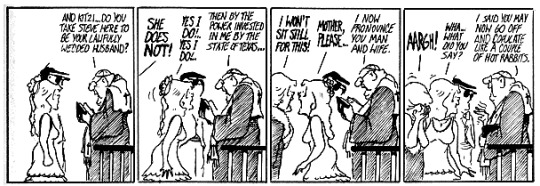
Overall though Waltz, despite an awkward start is a decent strip.. dated sure, it was made several decades ago, but not all that bad and enjoyable enough if your a fan of Bloom County, though it's also easy enough to read once out of curosity and then never again, but i'm glad I went through it again for the Cutter John flashback and Rabies alone, and i'm equally as glad it is out there for the curious party to see where BLoom County began.
Naturally you can tell the story dosen't end here... next time Berke goes national and gets syndicated by the Washington Post as he tries to find his footing as a comic stripper and we take our first trip down to Bloom County and meet a wide variety of colorful characters.. that by year two will mostly be gone. Until next time, courage.

#bloom county#berkley brethead#comic strips#comics#the 70's#retrospective#bloomtrospective#the academia waltz#university of texas#steve dallas#rabies#dogs#penguins
0 notes